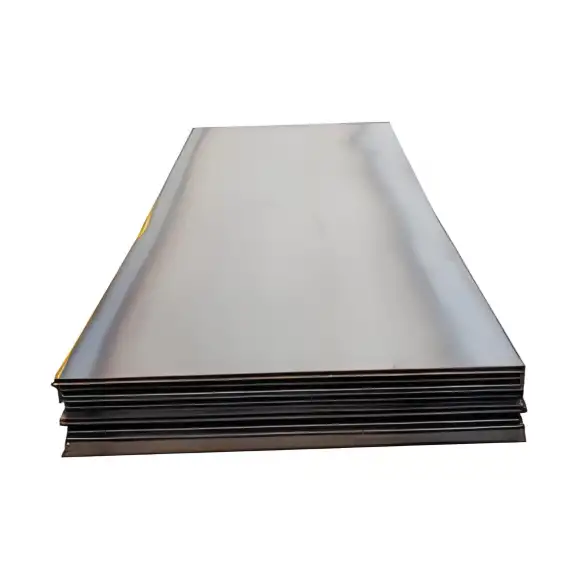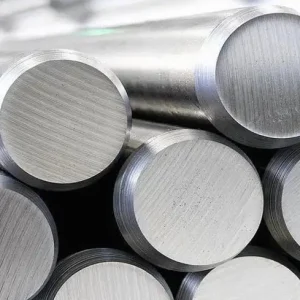AR400 is a workhorse abrasion-resistant (AR) quenched-and-tempered plate that delivers a practical balance of surface hardness (typically ≈360–444 HBW/BHN) and toughness, making it the preferred choice for medium-to-heavy abrasive service where formability, weldability and impact resistance matter more than maximum penetration resistance; globally, commodity Chinese AR400 (NM400) can be found in ~$400–$1,050/metric-ton range FOB/EXW while branded or certified AR/HARDOX equivalents often trade higher (commonly ~$600–$2,000/metric-ton depending on thickness, quantity and origin).
What is AR400 steel plate?
AR400 is shorthand for an abrasion-resistant carbon/low-alloy plate which is specified by nominal Brinell hardness rather than a single chemical standard. Typical stock AR400 is quenched and tempered to produce a through-hardness in the ~360–444 BHN band (nominally “400” BHN), aimed at resisting two-body abrasion while retaining ductility and toughness for equipment exposed to impact and sliding wear. Because the AR label is hardness-driven, chemistry and exact mechanical values vary by mill and country, always request mill test certificates and hardness maps for critical parts.
How AR400 is made
-
Steelmakers produce AR plate by selecting a chemistry (carbon + manganese + small alloy additions) and then quenching and tempering the plate to produce the desired hardness/toughness combination.
-
“Formable” variants are often sold as AR400F (or “400F”) — these are processed to improve bendability without cracking, useful when you need curved liners or pressed shapes.
Typical chemical composition
Note: AR grades are defined by hardness; composition differs by source. This table gives typical ranges found across major suppliers (representative, not a specification).
| Element | Typical range (wt%) |
|---|---|
| Carbon (C) | 0.12 – 0.40 |
| Manganese (Mn) | 0.8 – 2.0 |
| Silicon (Si) | 0.25 – 0.80 |
| Chromium (Cr) | 0.20 – 1.50 |
| Molybdenum (Mo) | 0.00 – 0.60 |
| Phosphorus (P) | ≤ 0.025 |
| Sulfur (S) | ≤ 0.005 |
Sources from service centers and mill data show variation by thickness and heat treatment; always check the supplier’s mill certificate for the lot you buy.
Mechanical and physical properties (representative values)
| Property | Typical AR400 range (representative) |
|---|---|
| Brinell Hardness (BHN/HBW) | 360 – 444 (nominal 400) |
| Tensile strength | ≈ 1,200 – 1,700 MPa (varies widely by heat/chemistry) |
| Yield strength | ≈ 800 – 1,400 MPa |
| Elongation (A%) | 8 – 20% (depends on thickness & heat) |
| Charpy impact (notch) | Application & thickness dependent (specify temperature if critical) |
| Density | 7.85 g/cm³ (standard steel density — use for weight calcs) |
The BHN figure is the defining measure for AR plate performance; other mechanicals are informative but less strictly guaranteed unless called out on the MTC.
Typical AR400 plate specifications and stock sizes
Suppliers commonly stock AR400 in hot-rolled quenched & tempered condition. Typical available thicknesses and plate sizes (examples from stockists):
| Thickness (inches / mm) | Common sheet widths (in / mm) | Common lengths (ft / mm) |
|---|---|---|
| 3/16″ (4.8 mm) – 1/2″ (12.7 mm) | up to 96″ (2438 mm) | up to 288″ (7315 mm) |
| 1/2″ – 1″ (12.7 – 25.4 mm) | up to 96″ | up to 288″ |
| 1″ – 4″ (25.4 – 101.6 mm) | industry variable | industry variable |
Examples: many service centers list stock from 3/16″ up to 4″; brand plates like Hardox®400 have published dimension ranges. For any critical application confirm the mill, temper, and dimensional tolerances before purchase.
Weight and thickness — quick calculator + sample weights
Quick rule: steel density ≈ 7.85 g/cm³ → 1″ thick steel weighs ≈ 40.79 lb/ft² (≈ 198.9 kg/m² per 1 cm thickness).
Example weight table (per square foot):
| Thickness | Weight (lb/ft²) |
|---|---|
| 1/8″ | 5.10 |
| 1/4″ | 10.21 |
| 1/2″ | 20.42 |
| 3/4″ | 30.63 |
| 1″ | 40.84 |
(You can compute precisely: weight(lb) = area(ft²) × thickness(in) × 5.085 (lb/ft² per 1/8″), or use the standard 40.79 lb/ft² per 1″ for design.) MetalsDepot and many suppliers publish the identical 1″ = ≈40.8 lb/ft² figure.
What is AR400 equivalent to?
AR400 is commonly cross-referenced with other brand and regional names; approximate equivalents include:
-
Hardox® 400 (SSAB branding) — recognized brand equivalent and often higher-guarantee product.
-
NM400 / NM450 (Chinese/Japanese style designations used by mills) — NM400 commonly aligns with AR400 hardness.
-
XAR 400 / EN designations — some European mills use XAR nomenclature for wear plate.
Because chemistry/treatment differ, “equivalent” is a shorthand — require mill certificates and hardness testing for interchangeability.
What is AR400 steel rated for?
AR400 is chosen where sliding and moderate impact abrasion are dominant and you need:
-
Truck bodies, dump liners, hoppers, chutes and feed ramps
-
Bucket liners and cutting edges for earth-moving equipment in moderate abrasive soils
-
Wear strips, guide rails and crusher parts where geometry is important and bending/forming may be necessary
When project exposure includes heavy impact, high-velocity particle impingement, or ballistic threats, choose a higher hardness grade (AR450 / AR500) or a specialized alloy. For thin sections that must be welded into structural frames, confirm design acceptance; AR plates are wear products, not structural steels, unless specifically qualified.
What is the difference between AR400 and AR500 plate?
-
Hardness & abrasion resistance: AR500 is harder (nominal ~500 BHN) and will resist penetration and high-severity abrasion better than AR400.
-
Toughness & ductility: AR400 is generally easier to form, bend and weld; it usually has higher toughness under impact than AR500 in the same thickness.
-
Fabrication: AR400 can be cut and welded with fewer preheat/post-heat restrictions; AR500 often requires stricter preheat and may crack if formed without proper procedure.
-
Selection rule of thumb: Choose AR400 where service includes a mix of abrasion and impact and you must bend or weld in shop; choose AR500 where maximum surface hardness and wear life under high-severity abrasion dominate.
Welding, cutting and fabrication notes
-
Use compatible filler metals and control heat input. For thicker AR plate or high strength alloys, preheat and interpass temperature control reduce cold cracking risk.
-
For AR400F (formable) material, shop bending is easier — still, verify bend radii with the mill.
-
Plasma or oxy-fuel cutting is common; laser/oxyfuel/plate-saws are usable but check for heat-affected zone (HAZ) hardening when post-heat treatment is not possible.
-
After welding heavy wear plates in service parts, perform hardness checks across the weld and HAZ when dimensional life is safety-critical.
AR400 steel plate price 2025: United States, Europe, China
Prices for AR plate vary strongly by brand (branded Hardox vs commodity NM/AR), thickness, order quantity, delivery terms (EXW/FOB/CIF) and current steel cycles. The table below gives representative 2025 ranges observed from service centers, marketplaces and market reporting; treat these as market-sensing figures rather than fixed quotations.
| Region / source | Representative AR400 price range (USD / metric ton) | Notes |
|---|---|---|
| China (commodity NM/AR) | $400 – $1,050 / t (many FOB/EXW listings on marketplaces). | Lower end for very large lots, higher for small MOQ and thicker plates. |
| Branded (SSAB Hardox® 400 or similar) | $600 – $2,000 / t (brand premium, certificate, and guaranteed properties). | Branded plate often commands higher price and supply assurance. |
| United States (domestic service center / market) | $800 – $2,200 / t (hot-rolled and value-added; US spot HRC and plate cycles influence). | Tariffs, freight and domestic margins widen spreads vs imports. |
| Europe (market & branded) | €500 – €1,500 / t (converted USD ≈ $550 – $1,650 / t) | European availability and brand presence affect price; branded plate often premium. |
Buying tips: request exact thickness pricing, MTC, hardness map, and whether the plate is “formable” (F) or standard AR. Ask suppliers to state delivery term (EXW/FOB/CIF), MOQ and lead time — these materially affect landed cost.
Environmental, safety and inspection guidance
-
Track wear using simple gauges or template mapping to measure remaining thickness and predict replacement intervals.
-
For critical installations, perform hardness mapping across the plate surface and in the HAZ after welding or repair.
-
Recycle worn AR plate as scrap steel when end of life is reached; most AR chemistries are recyclables in steel scrap streams with small alloy premiums/discounts.
FAQs
-
Can AR400 be welded to mild steel?
Yes, with matched welding procedures and appropriate filler metal; control heat input and cool rates to avoid HAZ cracking on heavier sections. -
Is AR400 magnetic?
Yes. AR400 is a carbon/low-alloy steel and is ferromagnetic. -
Can I bend AR400 plate?
Short answer: thin AR400 or AR400F can be bent; verify bend radii with supplier data. Thick plate will require press brakes and may need pre-heating. -
Will AR400 work for high-impact hammering?
AR400 tolerates impact better than very hard grades, but for severe impact or ballistic service consider alternate materials. -
Is AR400 structural steel?
No, AR grades are wear plates; they are not automatically certified for structural weldments unless the mill supplies relevant certifications. -
Does AR400 rust?
Yes. it is carbon steel; apply coatings or maintain corrosion protection if environment requires. -
How do I check plate hardness?
Use a Brinell hardness tester or request mill hardness tests on the MTC (mill test certificate). -
What influences AR400 longevity?
Abrasive type, particle velocity, impact severity, plate orientation and maintenance intervals all change life expectancy. -
Is AR400 the same as Hardox®400?
Not identical, Hardox®400 is SSAB’s branded product with defined guarantees; AR400 is a generic hardness class. Compare MTCs. -
If I need less welding difficulty, is AR400 a good choice?
Yes. compared to AR500, AR400 is generally easier to cut, weld and form.
Why buy AR400 from MWalloys
MWalloys supplies AR400 and equivalent wear plates from our Chinese mills and selected global producers. We offer:
-
100% factory-direct pricing (factory EXW/FOB options) to give you competitive landed cost;
-
Fast stock & delivery for common thicknesses (many lots available for immediate shipment);
-
Full documentation (MTC, hardness reports, certificates) and value-added services (plasma cutting, CNC profiling, surface treatment) to reduce your shop lead time.
If you require a quotation, include thickness, quantity (tons or m²), desired hardness and delivery term — we will return a mill-certified offer. (This paragraph is a supplier statement and reflects MWalloys’ commercial capability.)





